Cellulose Nanocrystal Membranes as Excipients for Drug Delivery Systems
Abstract
:1. Introduction
2. Experimental Procedure
2.1. Materials
2.2. Cavitation-Induced Acid Hydrolysis
2.3. Membrane Production
2.4. Characterization
2.4.1. Raw Material Chemical Composition
2.4.2. Infrared Spectroscopy (FTIR-ATR)
2.4.3. Gravimetric Analysis
2.4.4. Size Measurement and Zeta Potential
2.4.5. Nuclear Magnetic Resonance (NMR)
2.4.6. X-ray Diffraction (XRD)
2.4.7. Atomic Force Microscopy (AFM)
2.4.8. Release Study
2.4.9. Antibacterial Activity
Characterization of the Standard Drug
Inoculum
Determination of MIC
Determination of MBC
Antibacterial Activity of the Drug Delivery System
Bacterial Strains and Culture Conditions
3. Results and Discussion
3.1. Raw Material Chemical Composition
3.2. FTIR-ATR Spectroscopic Analysis
3.3. Colloid Solution Analysis
3.4. Nuclear Magnetic Resonance (NMR) Analysis
3.5. Size Measurement
3.6. Yield and Zeta Potential
3.7. X-ray Diffraction (XRD)
3.8. Atomic Force Microscopy (AFM)
3.9. Drug Release
3.10. Antibacterial Activity
3.10.1. Minimum Inhibitory Concentration (MIC) and Minimum Bactericidal Concentration (MBC) of Chlorhexidine
3.10.2. Modified Direct Contact Test (mDCT)
4. Conclusions
Acknowledgments
Author Contributions
Conflicts of Interest
References
- Alila, S.; Besbes, I.; Vilar, M.R.; Mutjé, P.; Boufi, S. Non-woody plants as raw materials for production of microfibrillated cellulose (MFC): A comparative study. Ind. Crops Prod. 2013, 41, 250–259. [Google Scholar] [CrossRef]
- Bos, H.L.; Van den Oever, M.J.A.; Peters, O.C.J.J. Tensile and compressive properties of flax fibres for natural fibre reinforced composites. J. Mater. Sci. 2002, 37, 1683–1692. [Google Scholar] [CrossRef]
- Jonoobi, M.; Oladi, R.; Davoudpour, Y.; Oksman, K.; Dufresne, A.; Hamzeh, Y.; Davodi, R. Different preparation methods and properties of nanostructurated cellulose from various natural resources and residues: A review. Cellulose 2015, 22, 935–969. [Google Scholar] [CrossRef]
- Bondeson, D.; Mathew, A.; Oksman, K. Optimization of the isolation of nanocrystals from microcrystalline cellulose by acid hydrolysis. Cellulose 2006, 13, 171–180. [Google Scholar] [CrossRef]
- Li, J.; Zhang, X.; Zhang, M.; Xiu, H.; He, H. Ultrasonic enhance acid hydrolysis selectivity of cellulose with HCl-FeCl3 as catalyst. Carbohydr. Polym. 2015, 117, 917–922. [Google Scholar] [CrossRef] [PubMed]
- Moriana, R.; Vilapana, F.; Karlsson, S.; Ribes, A. Correlation of chemical, structural and thermal properties of natural fibres for their sustainable exploitation. Carbohydr. Polym. 2014, 112, 422–431. [Google Scholar] [CrossRef] [PubMed]
- Li, W.; Wang, R.; Liu, S. Nanocrystalline cellulose prepared from softwood kraft pulp via ultrasonic assisted acid hydrolysis. BioResources 2011, 6, 4271–4281. [Google Scholar]
- Montes, S.; Azcune, I.; Cabañero, G.; Grande, H.-J.; Odriozola, I.; Labidi, J. Functionalization of Cellulose Nanocrystals in Choline Lactate Ionic Liquid. Materials 2016, 9, 499. [Google Scholar] [CrossRef]
- Kolakovic, R.; Laaksonen, T.; Peltonen, L.; Laukkanen, A.; Hirvonen, J. Spraydried nanofibrillar cellulose microparticles for sustained drug release. Int. J. Pharm. 2012, 430, 44–55. [Google Scholar] [CrossRef] [PubMed]
- Lavoine, N.; Desloges, I.; Sillard, C.; Bras, J. Controlled release and long-term antibacterial activity of chlorhexidine digluconate through the nanoporous network of microfibrillated cellulose. Cellulose 2014, 21, 4429–4442. [Google Scholar] [CrossRef]
- Veeramachineni, A.K.; Sathasivam, T.; Muniyandy, S.; Janarthanan, P.; Langford, S.J.; Yan, L.Y. Optimizing Extraction of Cellulose and Synthesizing Pharmaceutical Grade Carboxymethyl Sago Cellulose from Malaysian Sago Pulp. Appl. Sci. 2016, 6, 170. [Google Scholar] [CrossRef]
- Wang, C.; Huang, H.; Jia, M.; Jin, S.; Zhao, W.; Cha, R. Formulation and evaluation of nanocrystalline cellulose as a potential disintegrant. Carbohydr. Polym. 2015, 130, 275–279. [Google Scholar] [CrossRef] [PubMed]
- Attin, T.; Abouassi, T.; Becker, K.; Wiegand, A.; Roos, M.; Attin, R. A new method for chlorhexidine (CHX) determination: CHX release after application of differently concentrated CHX-containing preparations on artificial fissures. Clin. Oral Investig. 2008, 12, 189–196. [Google Scholar] [CrossRef] [PubMed]
- Yerushalmi, S.M.; Buck, M.E.; Lynn, D.M.; Lemcoff, N.G.; Meijler, M.M. Multivalent Alteration of Quorum Sensing in Staphylococcus aureus. Chem. Commun. 2013, 49, 5177–5179. [Google Scholar] [CrossRef] [PubMed]
- Robles, E.; Urruzola, I.; Labidi, J.; Serrano, L. Surface modified nano-cellulose as reinforcement in poly(lactic acid) to conform new composites. Ind. Crops Prod. 2015, 71, 44–53. [Google Scholar] [CrossRef]
- Smoluchowski, M. Contribution to the theory of electro-osmosis and related phenomena. Bull. Int. Acad. Sci. Crac. 1903, 3, 184–199. [Google Scholar]
- He, J.; Shizhong, C.; Wang, S. Preparation and crystalline analysis of high-grade bamboo dissolving pulp for cellulose acetate. J. Appl. Polym. Sci. 2008, 107, 1029–1038. [Google Scholar] [CrossRef]
- Segal, L.; Creely, J.J.; Martin, A.E., Jr.; Conrad, C.M. An empirical method for estimating the degree of crystallinity of native cellulose using the X-ray diffractometer. Text. Res. J. 1959, 29, 786–794. [Google Scholar] [CrossRef]
- French, A.D.; Santiago Cintrón, M. Cellulose polymorphy, crystallite size, and the Segal Crystallinity Index. Cellulose 2013, 20, 583–588. [Google Scholar] [CrossRef]
- Park, S.; Baker, J.O.; Himmel, M.E.; Parilla, P.A.; Johnson, D.K. Cellulose crystallinity index: Measurement techniques and their impact on interpreting cellulose performance. Biotechnol. Biofuels 2010, 3, 10. [Google Scholar] [CrossRef] [PubMed]
- Urruzola, I.; Robles, E.; Serrano, L.; Labidi, J. Nanopaper from almond (Prunus dulcis) shell. Cellulose 2014, 21, 1619–1629. [Google Scholar] [CrossRef]
- Hult, E.L.; Iversen, T.; Sugiyama, J. Characterization of the supermolecular structure of cellulose in wood pulp fibres. Cellulose 2003, 10, 103–110. [Google Scholar] [CrossRef]
- Terinte, N.; Ibbett, R.; Schuster, K.C. Overview on native cellulose and microcrystalline cellulose I structure studied by X-ray diffraction (WAXD): Comparison between measurement techniques. Lenzing. Ber. 2011, 89, 118–131. [Google Scholar]
- Scherrer, P. Bestimmung der Größe und der inneren Struktur von Kolloidteilchen mittels Röntgenstrahlen. Nachr. Ges. Wiss. Gött. Math.-Phys. Kl. 1918, 1918, 98–100. [Google Scholar]
- Warren, B.E. X-ray Diffraction; Addison-Wesley Pub. Co.: Reading, MA, USA, 1969. [Google Scholar]
- Pfaller, M.A.; Messer, S.A.; Coffman, S. Comparison of visual and spectrophotometric methods of MIC endpoint determinations by using broth microdilution methods to test five antifungal agents, including the new triazole D0870. J. Clin. Microbiol. 1995, 33, 1094–1097. [Google Scholar] [PubMed]
- Felício, R.; Albuquerque, S.; Young, M.C.M.; Yokoya, N.S.; Debonsi, H.M. Trypanocidal, leishmanicidal and antifungal potential from marine red alga Bostrychia tenella J. Agardh (Rhodomelaceae, Ceramiales). J. Pharm. Biomed. Anal. 2008, 52, 763–769. [Google Scholar] [CrossRef] [PubMed]
- Zhang, H.; Shen, Y.; Ruse, N.D.; Haapasalo, M. Antibacterial Activity of Endodontic Sealers by Modified Direct Contact Test against Enterococcus Faecalis. J. Endod. 2009, 35, 1051–1055. [Google Scholar] [CrossRef] [PubMed]
- Abdul Khalil, H.P.S.; Rozman, H.D.; Ahmad, M.N.; Ismail, H. Acetylated Plant-Fiberreinforced Polyester Composites: A Study of Mechanical, Hygrothermal, and Aging Characteristics. Polym.-Plast. Technol. 2000, 39, 757–781. [Google Scholar] [CrossRef]
- Thygesen, A.; Madsen, B.; Bjerre, A.B.; Lilholt, H. Cellulosic Fibers: Effect of Processing on Fiber Bundle Strength. J. Nat. Fibers 2011, 8, 161–175. [Google Scholar] [CrossRef]
- Sun, X.F.; Sun, R.C.; Fowler, P.; Baird, M.S. Isolation and characterization of cellulose obtained by a two-stage treatment with organosolv and cyanamide activated hydrogen peroxide from wheat straw. Carbohydr. Polym. 2004, 55, 379–391. [Google Scholar] [CrossRef]
- Buschle-Diller, G.; Inglesby, M.K.; Wu, Y. Physicochemical properties of chemically and enzymatically modified cellulosic surfaces. Colloids Surf. A 2005, 260, 63–70. [Google Scholar] [CrossRef]
- Revol, J.F.; Bradford, H.; Giasson, J.; Marchessault, R.H.; Gray, D.G. Helicoidal self-ordering of cellulose microfibrils in aqueous suspension. Int. J. Biol. Macromol. 1992, 14, 170–172. [Google Scholar] [CrossRef]
- Gast, J.C.; Atalla, R.H.; McKelvey, R.D. The 13C-n.m.r. spectra of the xylo- and cello-oligosaccharides. Carbohydr. Res. 1980, 84, 137–146. [Google Scholar] [CrossRef]
- French, A.D. Idealized powder diffraction patterns for cellulose polymorphs. Cellulose 2014, 212, 885–896. [Google Scholar] [CrossRef]
- Yu, H.Y.; Qin, Z.Y.; Liu, L.; Yang, X.G.; Zhou, Y.; Yao, J.M. Comparison of the reinforcing effects for cellulose nanocrystals obtained by sulfuric and hydrochloric acid hydrolysis on the mechanical and thermal properties of bacterial polyester. Compos. Sci. Technol. 2013, 87, 22–28. [Google Scholar] [CrossRef]
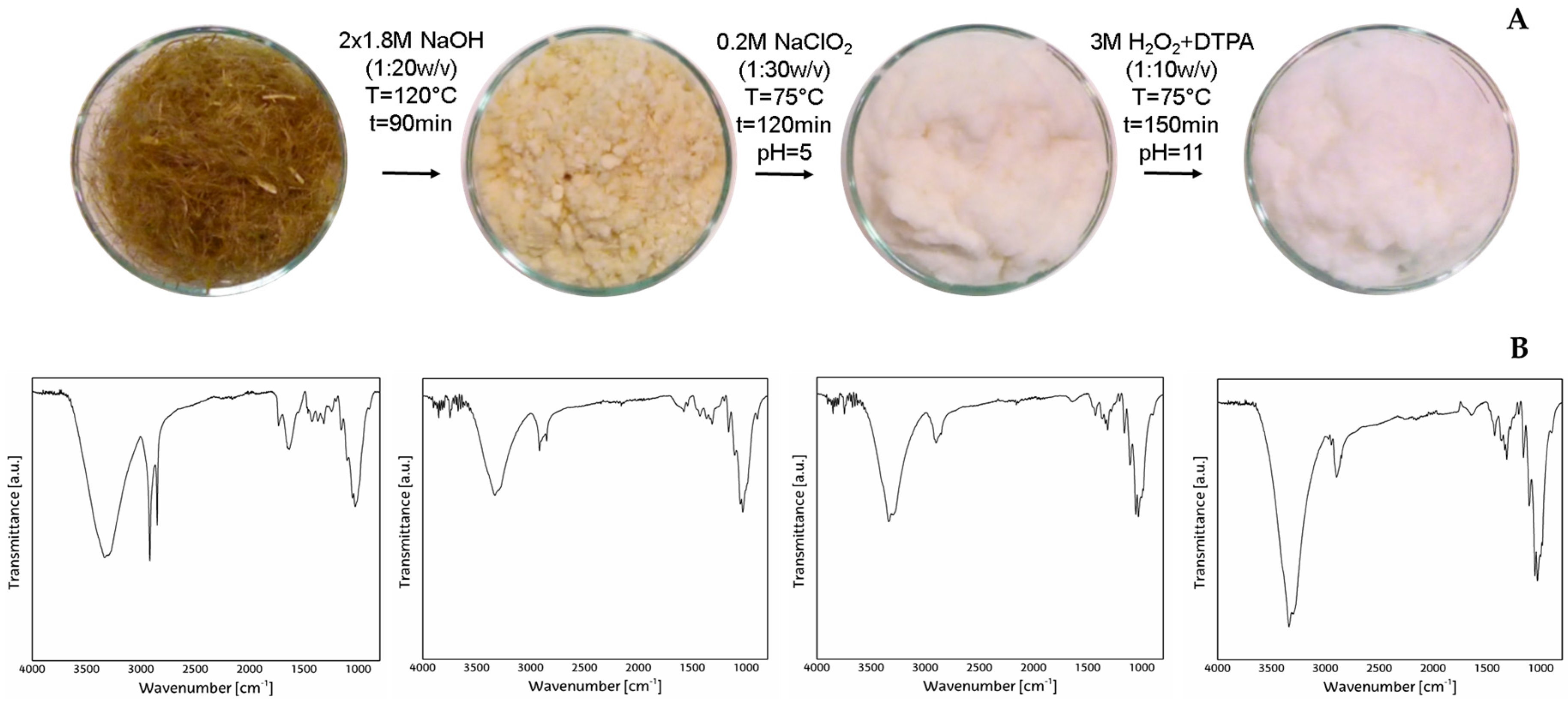

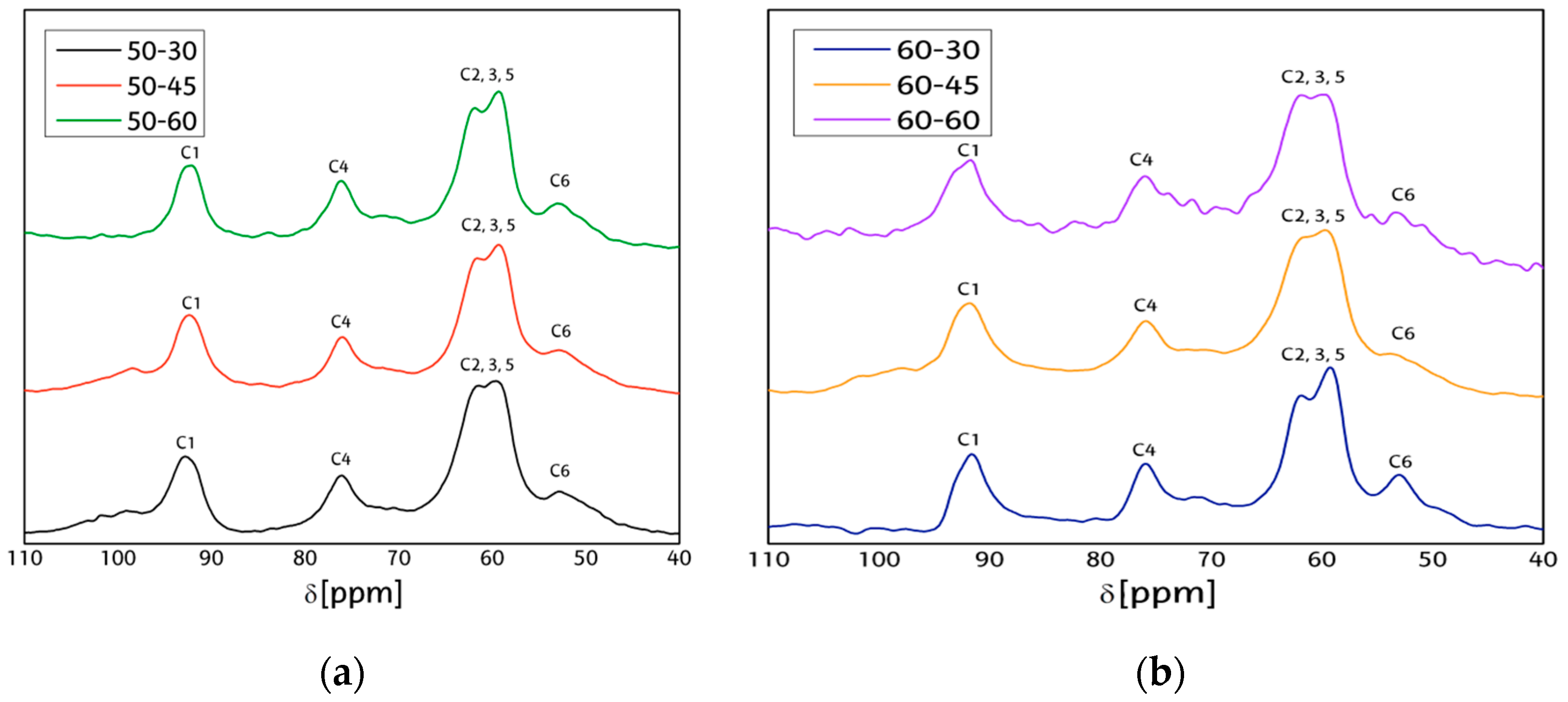
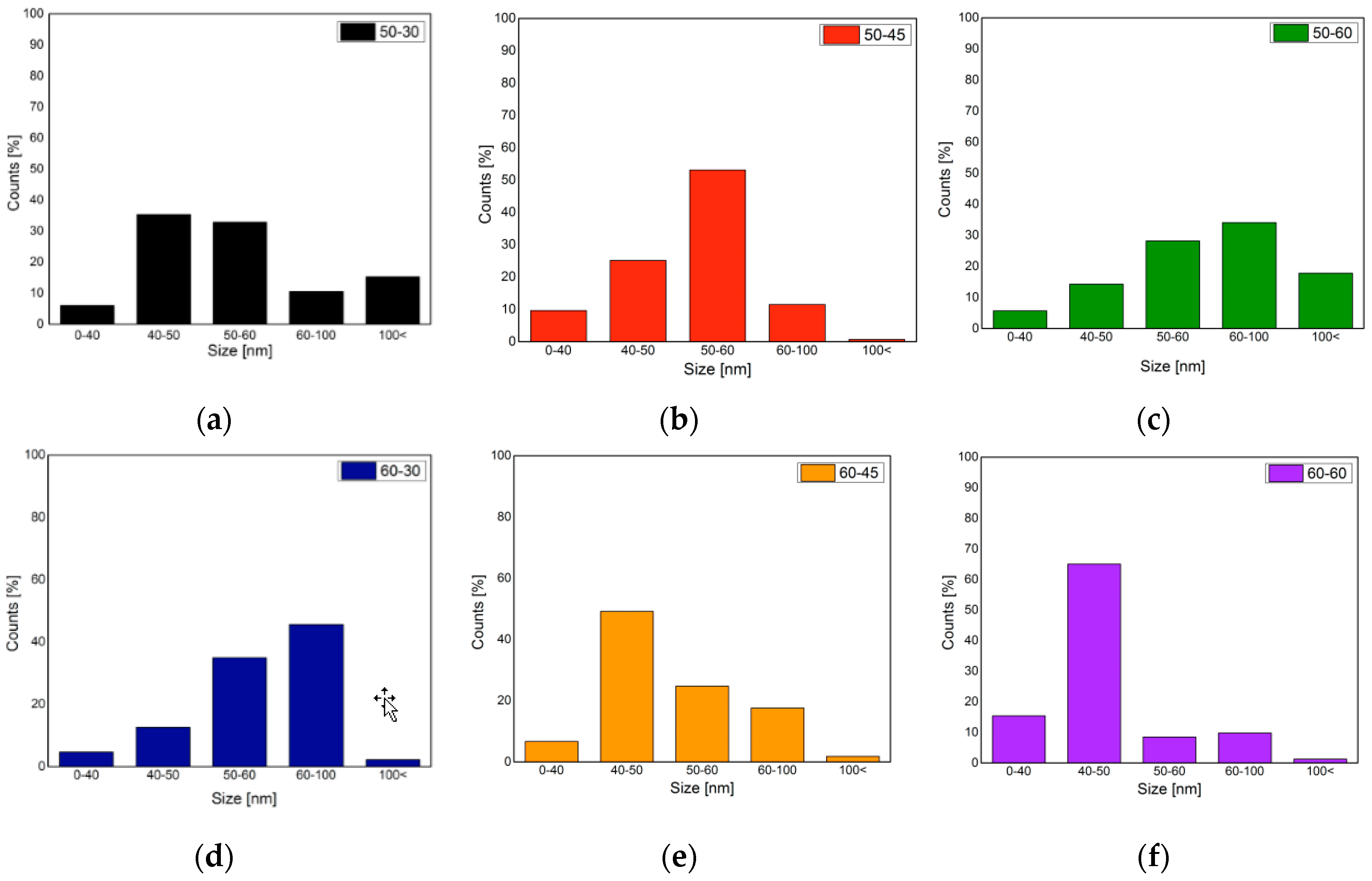
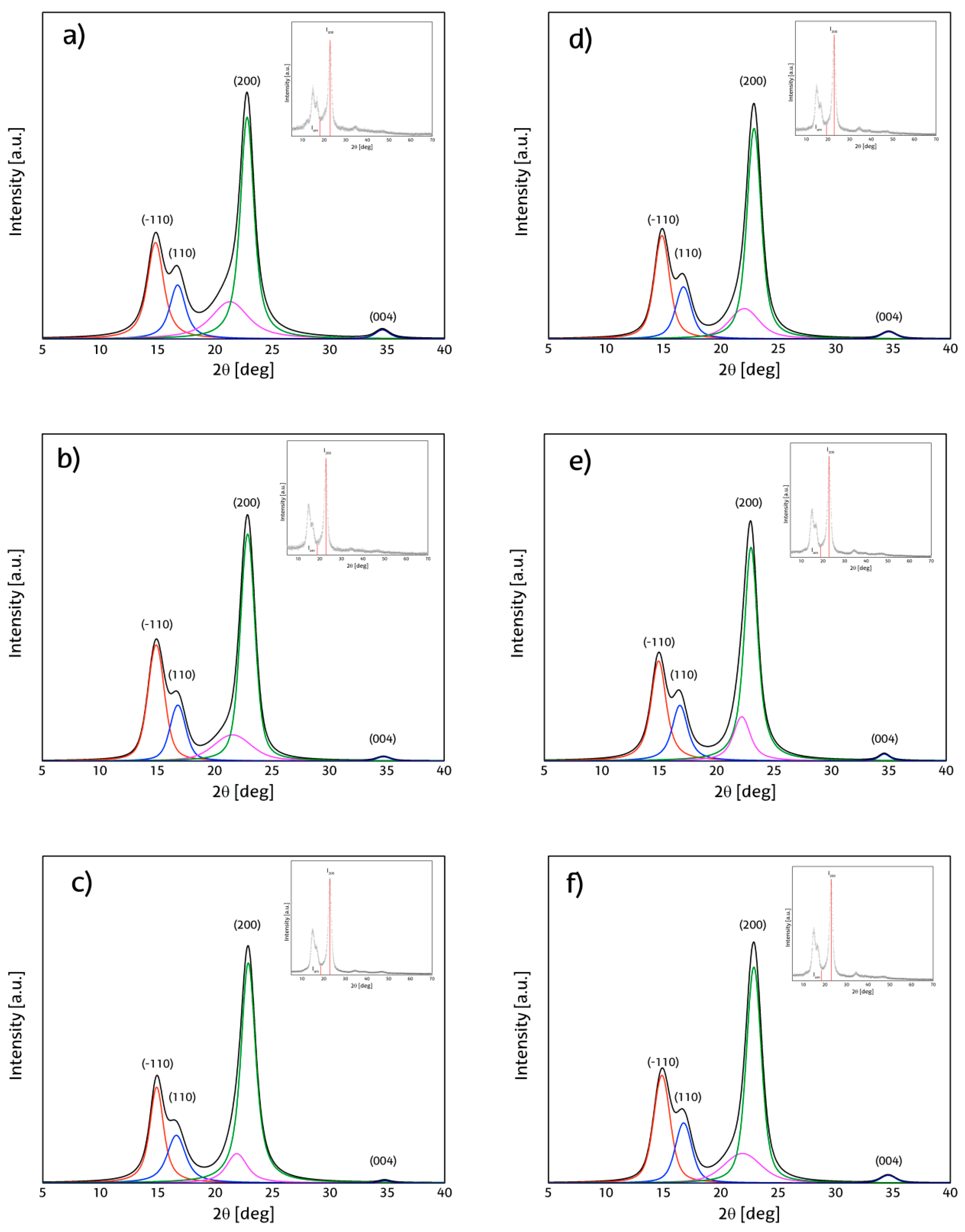
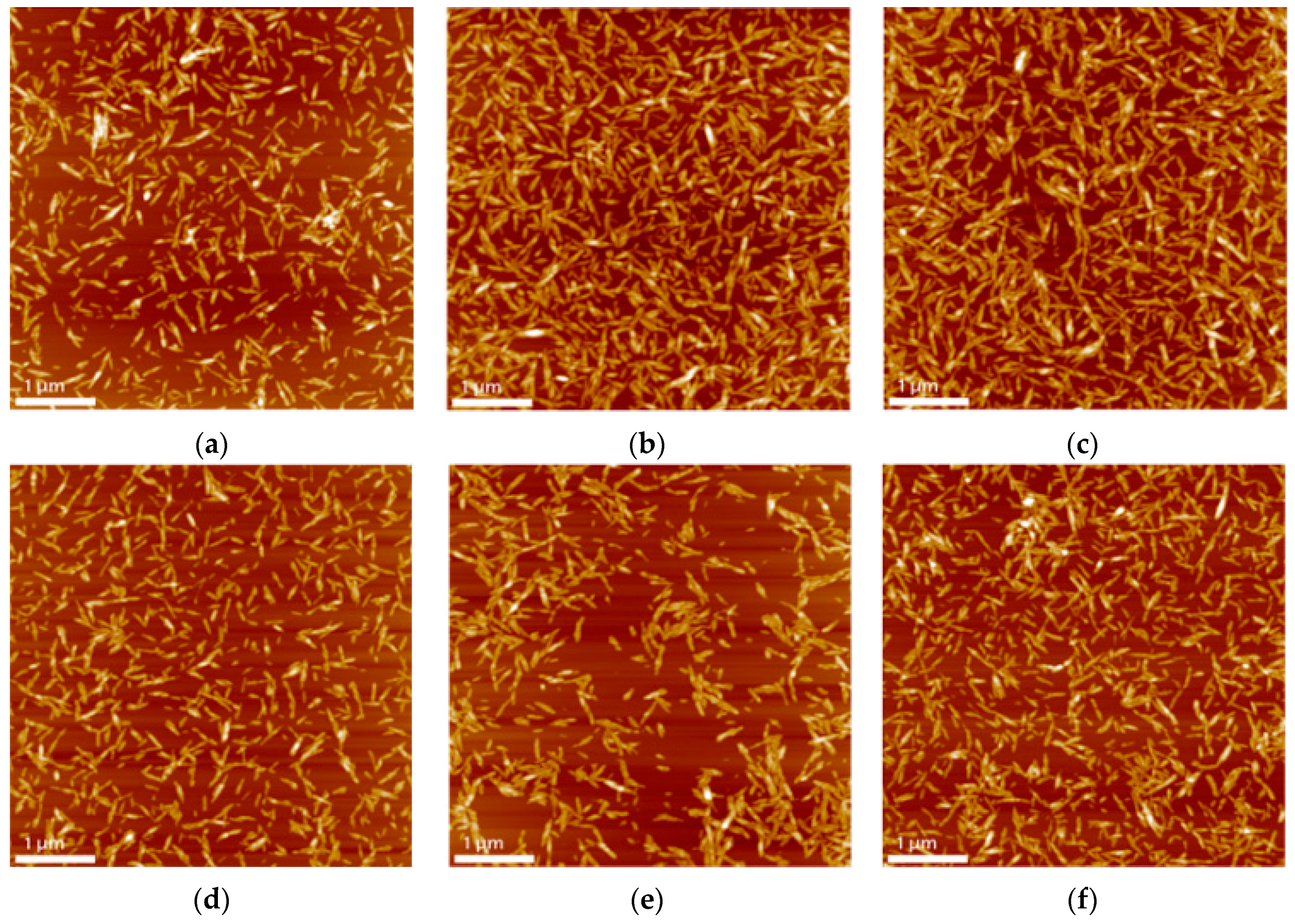
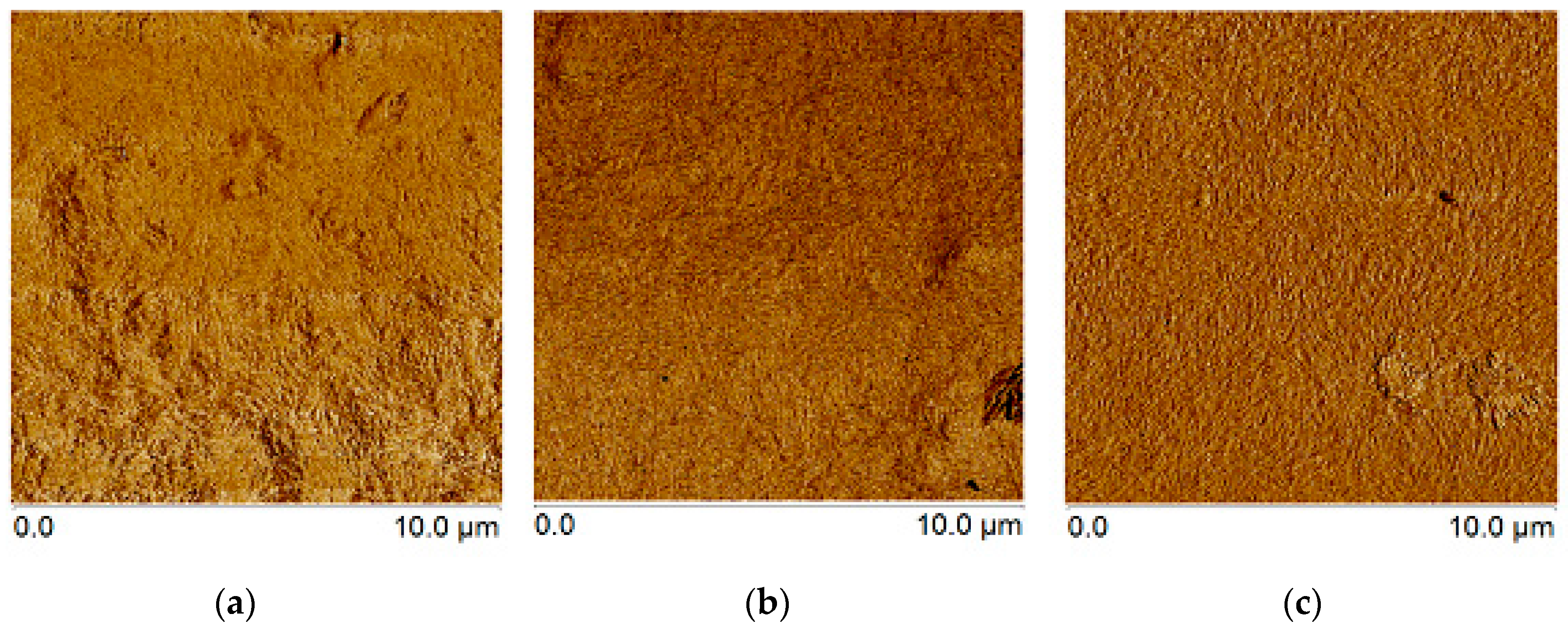
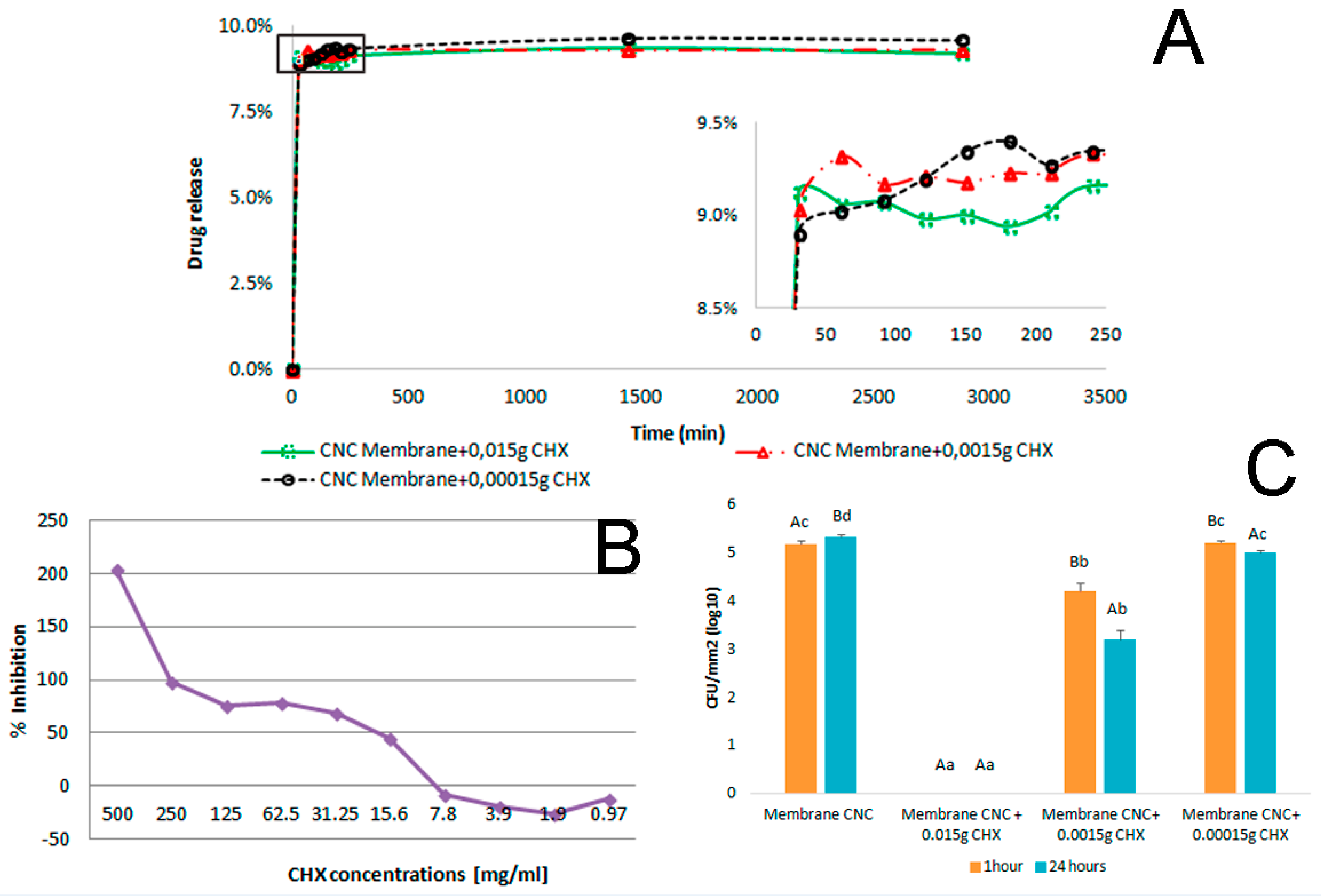
| Extractives | Lignin | Hemicelluloses | α-Cellulose |
|---|---|---|---|
| 2.58 ± 2.11 a | 1.70 ± 0.31 a | 15.42 ± 0.53 a | 63.91 ± 1 a |
| 1.70 c | 24.90 b | 13.70 b | 73.80 b |
| - | 2.8 ± 0.50 c | 8.7 ± 0.20 c | 77 ± 0.30 c |
| - | 4.70 d | 12.90 d | 68.70 d |
| Sample/Method | Crystallinity Index (%) | Yield (g/g) | Zeta Potential (mV) | δ200 (Å) | |
|---|---|---|---|---|---|
| Segal Method | Deconvolution Method | Scherrer Approximated | |||
| 50-30 | 86.17 | 80.19 | 0.0930 | −32.70 | 54.39 |
| 50-45 | 90.50 | 85.55 | 0.1799 | −24.30 | 51.91 |
| 50-60 | 91.63 | 91.23 | 0.4032 | −24.33 | 50.68 |
| 60-30 | 90.82 | 85.88 | 0.0656 | −26.57 | 53.40 |
| 60-45 | 90.89 | 87.93 | 0.1415 | −25.40 | 54.95 |
| 60-60 | 90.90 | 83.69 | 0.0808 | −31.35 | 50.01 |
| SAMPLES | RMS * |
|---|---|
| CNC + 0.015 g CHX | 44.85 |
| CNC + 0.0015 g CHX | 28 |
| CNC + 0.0015 g CHX | 5.87 |
© 2016 by the authors; licensee MDPI, Basel, Switzerland. This article is an open access article distributed under the terms and conditions of the Creative Commons Attribution (CC-BY) license (http://creativecommons.org/licenses/by/4.0/).
Share and Cite
Barbosa, A.M.; Robles, E.; Ribeiro, J.S.; Lund, R.G.; Carreño, N.L.V.; Labidi, J. Cellulose Nanocrystal Membranes as Excipients for Drug Delivery Systems. Materials 2016, 9, 1002. https://doi.org/10.3390/ma9121002
Barbosa AM, Robles E, Ribeiro JS, Lund RG, Carreño NLV, Labidi J. Cellulose Nanocrystal Membranes as Excipients for Drug Delivery Systems. Materials. 2016; 9(12):1002. https://doi.org/10.3390/ma9121002
Chicago/Turabian StyleBarbosa, Ananda M., Eduardo Robles, Juliana S. Ribeiro, Rafael G. Lund, Neftali L. V. Carreño, and Jalel Labidi. 2016. "Cellulose Nanocrystal Membranes as Excipients for Drug Delivery Systems" Materials 9, no. 12: 1002. https://doi.org/10.3390/ma9121002
APA StyleBarbosa, A. M., Robles, E., Ribeiro, J. S., Lund, R. G., Carreño, N. L. V., & Labidi, J. (2016). Cellulose Nanocrystal Membranes as Excipients for Drug Delivery Systems. Materials, 9(12), 1002. https://doi.org/10.3390/ma9121002









